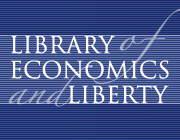
Paul Anthony Samuelson |

Samuelson's magnum opus, which did more than any other single book to spread the mathematical revolution in economics, was Foundations of Economic Analysis, based on his Harvard Ph.D. dissertation. In this book he showed how virtually all economic behavior could be understood as maximizing or minimizing subject to a constraint. Hicks had done something similar in his 1939 book, Value and Capital. But while Hicks relegated the math to appendices, "Samuelson," writes former Samuelson student Stanley Fischer, "flaunts his in the text."
Samuelson was one of the last generalists to be incredibly productive in a number of fields in economics. He has contributed fundamental insights in consumer theory and welfare economics, international trade, finance theory, capital theory, dynamics and general equilibrium, and macroeconomics.
Swedish economist Bertil Ohlin had argued that international trade would tend to equalize the prices of factors of production. Trade between India and the United States, for example, would narrow wage-rate differentials between the two countries. Samuelson, using mathematical tools, showed the conditions under which the differentials would be driven to zero. The theorem he proved is called the Factor Price Equalization Theorem.
In finance theory, which he took up at age fifty, Samuelson did some of the initial work that showed that properly anticipated futures prices should fluctuate randomly. Samuelson also did path-breaking work in capital theory, but his contributions are too complex to describe in just a few sentences.
Economists had long believed that there were goods that would be hard for the private sector to provide because of the difficulty of charging those who benefit from them. National defense is one of the best examples of such a good. Samuelson, in a 1954 article, was the first to attempt a rigorous definition of a public good.
In macroeconomics Samuelson demonstrated how combining the accelerator theory of investment with the Keynesian income determination model explains the cyclical nature of business cycles. He also introduced the concept of the neoclassical synthesis—a synthesis of the old neoclassical microeconomics and the new (in the fifties) Keynesian macroeconomics. According to Samuelson government intervention via fiscal and monetary policy is required to achieve full employment, but then at full employment the market works well, except at providing public goods and handling problems of externalities. James Tobin has called the neoclassical synthesis one of Samuelson's greatest contributions to economics.
In Linear Programming and Economic Analysis Samuelson and coauthors Robert Dorfman and Robert Solow applied optimization techniques to price theory and growth theory, thereby integrating these previously segregated fields.
Samuelson has been a prolific writer, averaging almost one technical paper a month for over fifty years. Some 338 of his articles are contained in the five-volume Collected Scientific Papers (1966-1986). He also has revised his immensely popular textbook, Economics, nearly every three years since 1948. This textbook, the best-selling one in the fifties, is translated into many languages. Samuelson once said, "Let those who will write the nation's laws if I can write its textbooks."
In 1970 Paul Samuelson became the first American to receive the Nobel Prize in economics. He won it "for the scientific work through which he has developed static and dynamic economic theory and actively contributed to raising the level of analysis in economic science."
Samuelson began teaching at the Massachusetts Institute of Technology in 1940 at the age of twenty-six, becoming a full professor six years later. He has remained there since. In addition to being honored with the Nobel Prize, Samuelson also earned the John Bates Clark Award in 1947—awarded for the most outstanding work by an economist under age forty. He was president of the American Economic Association in 1961.
Samuelson was born in Gary, Indiana. At age sixteen he enrolled at the University of Chicago, where he studied under Frank Knight, Jacob Viner, and other greats, and alongside fellow budding economists Milton Friedman and George Stigler, who were then graduate students. Samuelson went on to do his graduate work at Harvard University.
Samuelson, like Friedman, had a regular column in Newsweek from 1966 to 1981. But unlike Friedman, he did not and does not have a passionate belief in free markets or, for that matter, in government intervention in markets. His pleasure seemed to come from providing new proofs, demonstrating technical finesse, and turning a clever phrase.
Samuelson himself once said: "Once I asked my friend the statistician Harold Freeman, 'Harold, if the Devil came to you with the bargain that, in exchange for your immortal soul, he'd give you a brilliant theorem, would you do it?' 'No,' he replied, 'but I would for an inequality.' I like that answer."
Economics. 1948.
Foundations of Economic Analysis, 2d ed. 1982.
"Interactions between the Multiplier Analysis and the Principle of Acceleration." Review of Economics and Statistics (May 1939): 75-78.
"International Trade and the Equalization of Factor Prices." Economic Journal 58 (June 1948): 163-84.
(With Robert Dorfman and Robert Solow.) Linear Programming and Economic Activity. 1958.
"A Note on the Pure Theory of Consumers' Behavior." Economica NS 5 (February 1938): 61-71.
"The Pure Theory of Public Expenditure." Review of Economics and Statistics (November 1954): 387-89.
